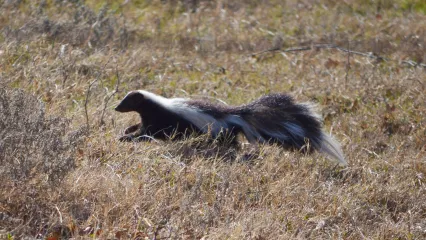
Description
A bed of sweet smelling roses? The most expensive perfume on the market? Mountain air? Hardly. The smell filling your nose is the musk spray of the striped skunk (Mephitis mephitis). Ranging all over Oklahoma, this animal is respected by many because of the strong musk smell it releases when provoked.
This not so sweet smelling animal is black all over except for two white stripes running from the rump and converging on the head to form a white cap. Their scent glands are located on each side of the anus, and powerful muscles surrounding the glands can spray the scent up to twelve feet. A common myth is that skunks cannot spray when they are held up by their tail, but this is not true. Because the spray can cause nausea and temporary blindness of the target, skunks are rarely attacked by other mammals. Skunks still face predators, however, including the coyote, bobcat and domestic dog, but perhaps the most danger to the skunk comes from the air. The great horned owl has a poor sense of smell, and its eyes are protected by a special eyelid, so the skunk's strong musk does little to prevent an attack from this predator. The striped skunk is the most common member of the weasel family. All members of the weasel family have scent glands, but none arc as powerful as the skunk's.
There are actually 13 subspecies of the striped skunk, the only differences being geographical location and size. The skunk is omnivorous, and its diet can include anything from nuts and berries to mice and chipmunks.
Size
On average they range from 20 to 28 inches long, including the seven to 10 inch tail. This small mammal only reaches about eight pounds. Except for the male averaging six percent bigger than females, both sexes are alike.
Habitat
It ranges anywhere from the woods and swamps to the suburbs, and it will den under buildings and in burrows so long as they are dry. Although skunks do not hibernate, they will often sleep through most of the winter.
Life Cycle
The male will stay in the same den as the females with which he will later mate. Breeding begins in late winter or early spring, and males will mate with multiple females. About 61 to 69 days after mating, the female will give birth, having anywhere from four to ten young, all blind and helpless. With in 20 minutes of their birth, however, they are able to start nursing. They will not be able to hear anything for about another 23 days, and eyesight will not come until a month after birth. At three months old, the young skunks will leave the family, although they won't be sexually mature until 11 months old. The average lifespan for a skunk in the wild is six years.
How To Observe
The best chance to view these creatures is at night, when they are foraging for food. Potent as their spray is, cautiousness should be used when observing them.


